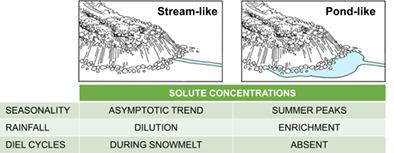当前位置:
X-MOL 学术
›
Hydrol. Process.
›
论文详情
Our official English website, www.x-mol.net, welcomes your feedback! (Note: you will need to create a separate account there.)
Contrasting physical and chemical conditions of two rock glacier springs
Hydrological Processes ( IF 3.2 ) Pub Date : 2021-04-02 , DOI: 10.1002/hyp.14159 Stefano Brighenti 1 , Michael Engel 1 , Monica Tolotti 2 , Maria Cristina Bruno 2 , Geraldene Wharton 3 , Francesco Comiti 1 , Werner Tirler 4 , Leonardo Cerasino 2 , Walter Bertoldi 5
Hydrological Processes ( IF 3.2 ) Pub Date : 2021-04-02 , DOI: 10.1002/hyp.14159 Stefano Brighenti 1 , Michael Engel 1 , Monica Tolotti 2 , Maria Cristina Bruno 2 , Geraldene Wharton 3 , Francesco Comiti 1 , Werner Tirler 4 , Leonardo Cerasino 2 , Walter Bertoldi 5
Affiliation

|
Rock glaciers are increasingly influencing the hydrology and water chemistry of Alpine catchments. During three consecutive summers (2017–2019), we monitored by recording probes and fortnightly/monthly field campaigns the physical and chemical conditions of two rock glacier springs (ZRG, SRG) in the Zay and Solda/Sulden catchments (Eastern Italian Alps). The springs have contrasting hydrological conditions with ZRG emerging with evident ponding (pond‐like), and SRG being a typical high‐elevation seep (stream‐like). Water temperature was constantly low (mean 1.2°C, standard deviation 0.1°C) at both springs. Concentrations of major ions (dominated by SO42−, HCO3−, Ca2+ and Mg2+) and trace elements (As, Sr, Ba, U, Rb) increased, and water became more enriched in heavy stable isotopes (δ18O, δ2H) towards autumn. This solute and isotopic enrichment had an asymptotic trend at SRG, and a unimodal pattern at ZRG, where peaks occurred 60–80 days after the snowmelt end. Wavelet analysis of electrical conductivity (EC) and water temperature records revealed daily cycles only at SRG, and significant weekly/biweekly fluctuations at both springs attributable to oscillations of meteorological conditions. Several rainfall events triggered a transient (0.5–2 h) EC drop (of 5–240 μS cm−1) and water temperature rise (of 0.2–1.4°C) at SRG (dilution and warming), whereas only intense rainfall events occasionally increased EC (by 15–85 μS cm−1) at ZRG (solute enrichment and thermal buffering), with a long‐lasting effect (6–48 h). Building on previous research, we suggest that rock glacier springs with differing flow conditions, that is, stream‐like and pond‐like, have contrasting fluctuations of water parameters at different timescales. Thus, for pond‐like springs, peaks of EC/solute concentrations might indicate a seasonal window of major permafrost thaw. Our quantitative description of the hydrochemical seasonality in rock glacier outflows and the physical and chemical response to precipitation events provides relevant information for water management in mountain areas under climate change.
中文翻译:

两个岩石冰川温泉的物理和化学条件的对比
岩石冰川正日益影响着高山流域的水文和水化学。在连续的三个夏季(2017-2019年)中,我们通过记录探针和每两周/每月进行一次野战监测,对扎伊和萨尔达/萨尔登流域(意大利东部阿尔卑斯山)的两个岩石冰川温泉(ZRG,SRG)的物理和化学状况进行了监测。春季的水文条件不同,ZRG出现明显的积水(类似池塘),而SRG是典型的高海拔渗流(类似河流)。两个弹簧的水温始终较低(平均1.2°C,标准偏差0.1°C)。主要离子浓度(以SO 4 2−,HCO 3 −,Ca 2+和Mg 2+为主)和微量元素(如,锶,钡,U,RB)增加,并且水成为重稳定同位素富集更(δ 18 O,δ 2 2H)朝秋天。这种溶质和同位素富集在SRG具有渐近趋势,在ZRG具有单峰模式,在融雪结束后60–80天出现峰值。对电导率(EC)和水温记录的小波分析显示,仅SRG处的日循环,而两个春季由于气象条件的振荡而出现的每周/每两周的显着波动。在SRG(稀释和变暖),几次降雨事件触发了瞬态(0.5–2 h)EC下降(5–240μScm -1)和水温升高(0.2–1.4°C),而偶尔只有强烈降雨事件EC增加(增加15–85μScm-1)在ZRG(溶质富集和热缓冲),具有长效作用(6-48小时)。在以前的研究的基础上,我们建议,具有不同水流条件的岩石冰川泉,即像河流一样和像池塘一样,在不同的时间尺度上具有不同的水参数波动。因此,对于类似池塘的泉水,EC /溶质浓度的峰值可能表明主要多年冻土融化的季节窗口。我们对岩冰川流出水化学季节的定量描述以及对降水事件的物理和化学响应的定量描述,为气候变化下山区的水资源管理提供了相关信息。
更新日期:2021-04-29
中文翻译:

两个岩石冰川温泉的物理和化学条件的对比
岩石冰川正日益影响着高山流域的水文和水化学。在连续的三个夏季(2017-2019年)中,我们通过记录探针和每两周/每月进行一次野战监测,对扎伊和萨尔达/萨尔登流域(意大利东部阿尔卑斯山)的两个岩石冰川温泉(ZRG,SRG)的物理和化学状况进行了监测。春季的水文条件不同,ZRG出现明显的积水(类似池塘),而SRG是典型的高海拔渗流(类似河流)。两个弹簧的水温始终较低(平均1.2°C,标准偏差0.1°C)。主要离子浓度(以SO 4 2−,HCO 3 −,Ca 2+和Mg 2+为主)和微量元素(如,锶,钡,U,RB)增加,并且水成为重稳定同位素富集更(δ 18 O,δ 2 2H)朝秋天。这种溶质和同位素富集在SRG具有渐近趋势,在ZRG具有单峰模式,在融雪结束后60–80天出现峰值。对电导率(EC)和水温记录的小波分析显示,仅SRG处的日循环,而两个春季由于气象条件的振荡而出现的每周/每两周的显着波动。在SRG(稀释和变暖),几次降雨事件触发了瞬态(0.5–2 h)EC下降(5–240μScm -1)和水温升高(0.2–1.4°C),而偶尔只有强烈降雨事件EC增加(增加15–85μScm-1)在ZRG(溶质富集和热缓冲),具有长效作用(6-48小时)。在以前的研究的基础上,我们建议,具有不同水流条件的岩石冰川泉,即像河流一样和像池塘一样,在不同的时间尺度上具有不同的水参数波动。因此,对于类似池塘的泉水,EC /溶质浓度的峰值可能表明主要多年冻土融化的季节窗口。我们对岩冰川流出水化学季节的定量描述以及对降水事件的物理和化学响应的定量描述,为气候变化下山区的水资源管理提供了相关信息。



























 京公网安备 11010802027423号
京公网安备 11010802027423号